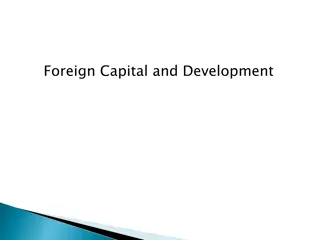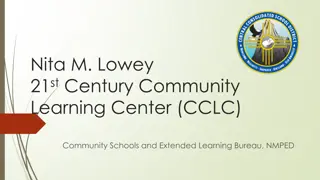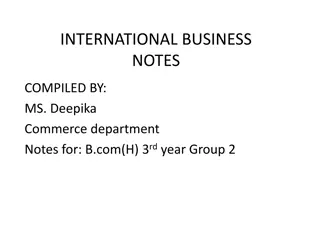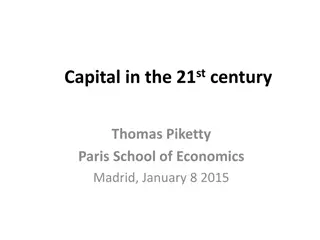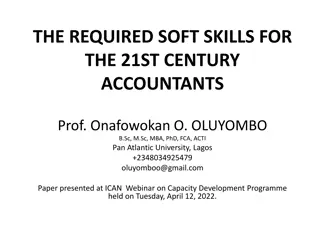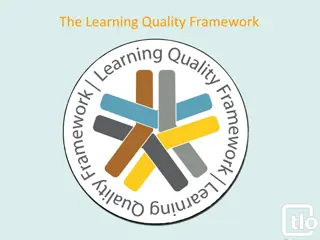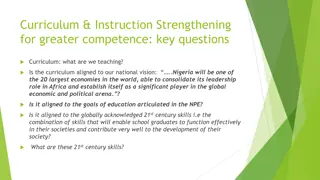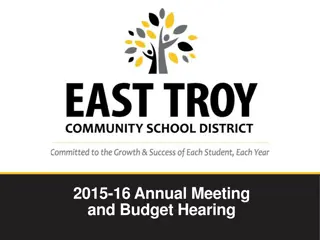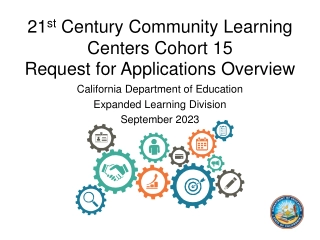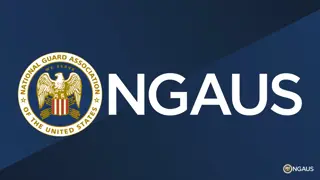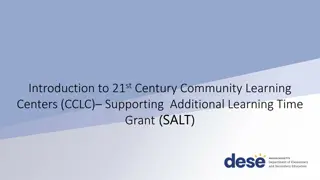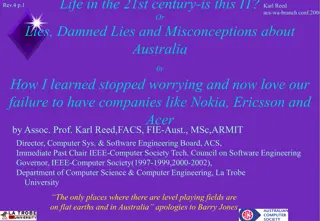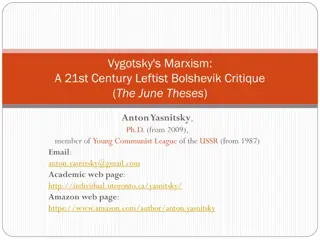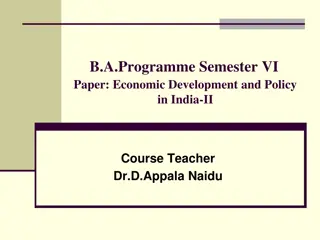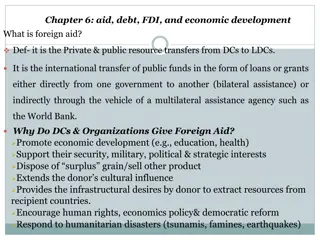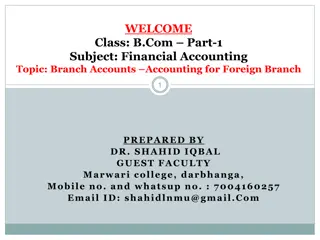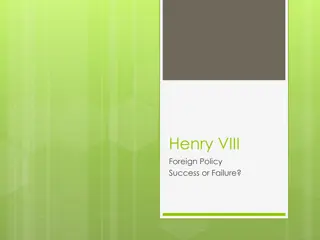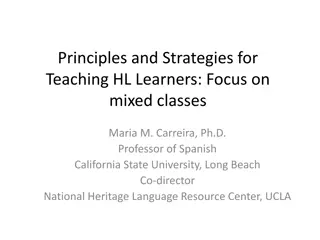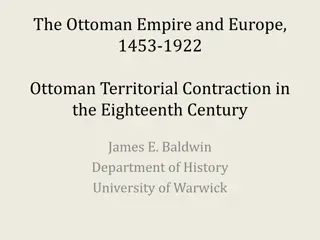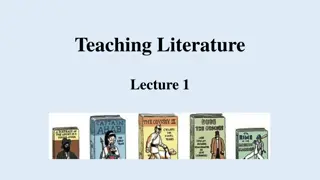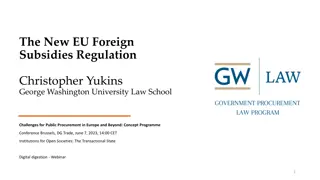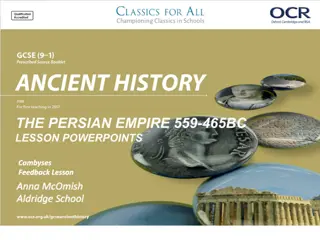Implementation of 21st Century Skills in Foreign Language Teaching: A Case Study
Facing the demands of a globalized world, integrating 21st Century Skills in foreign language teaching is vital for students' future success in various fields. This article explores the importance and implementation of these skills in teaching Arabic at universities in Indonesia and Malaysia, emphasizing critical thinking, creativity, collaboration, communication, character, and citizenship.
Download Presentation

Please find below an Image/Link to download the presentation.
The content on the website is provided AS IS for your information and personal use only. It may not be sold, licensed, or shared on other websites without obtaining consent from the author. Download presentation by click this link. If you encounter any issues during the download, it is possible that the publisher has removed the file from their server.
E N D
Presentation Transcript
Implementation of 21st Century Skills in Foreign Language Teaching: A Case Study of Arabic Language Teaching In Indonesian and Malaysian College No. Abstract: ABS-ICOLLITE-23161 Sofyan Sauri Universitas Pendidikan Indonesia
INTRODUCTION In facing an increasingly globalized world, foreign language proficiency and skills related to 21st Century Skills will help individuals to succeed in various fields such as business, diplomacy, education, and many more. Therefore, the integration of 21st Century Skills in foreign language learning is a must so that students are ready to face complex and diverse future demands. The urgency of 21st Century Skills in foreign language learning is very important because it reflects the needs and demands of the world that is constantly changing and developing in the 21st century. 21st Century Skills is a set of skills and competencies that are essential for individuals to succeed in a modern, highly connected, technology-based society. In the context of learning foreign languages, these skills are becoming increasingly important because foreign languages themselves are windows for communicating and interacting with various cultures and countries in an increasingly interconnected world. This article examines implementing 21st-century skills in teaching Arabic in universities in Indonesia and Malaysia. 21st-century skills are considered important in dealing with the rapidly changing demands of the modern world. These skills include critical thinking, creativity, collaboration, communication, character, and citizenship
LITERATURE REVIEW The skills needed for education and the workplace in the current economy have been labeled 21st-century skills. To define and systemize these skills, a number of initiatives have outlined frameworks. The Partnership for 21st Century Skills (Van Laar, et al., 2020) is a joint government corporate organization which lists three types of skills: learning skills (creativity and innovation; critical thinking and problem-solving; communication and collaboration), literacy skills (information literacy; media literacy; ICT literacy), and life skills (flexibility and adaptability; initiative and self-direction; social and cross-cultural skills; productivity and accountability; leadership and responsibility). Another initiative is the international research project Assessment and Teaching of 21st Century Skills (ATC21S). The ATC21S project resulted in 10 skills grouped into four categories: ways of thinking (creativity and innovation; critical thinking, problem-solving, and decision-making; learning to learn and metacognition), ways of working (communication; collaboration), tools for working (information literacy; ICT literacy), and living in the world (citizenship; life and career skills; personal and social responsibility) (Griffin, et al., et al., 2014). The 21st-century skillset is generally understood to encompass a range of competencies, including critical thinking, problem solving, creativity, meta-cognition, communication, digital and technological literacy, civic responsibility, and global awareness (Dede, 2010; Kim, 2019). And nowhere is the development of such competencies more important than in developing country contexts, where substantial lack of improvements in learning outcomes has suggested that the task of improving instructional quality is urgent. A challenge in bringing about the desired improvements lies in the lack of context-specific understanding of teaching practices as well as meaningful ways of supporting teachers in their professional development (Seidman et al., 2018; UNESCO, 2016; Wolf et al., 2018)
METHOD This study uses a qualitative approach and a case study design. Data was collected through class observations, interviews with Arabic lecturers, and analysis of documents related to teaching guidelines. The research sample comprised 25 lecturers at the Indonesian University of Education and the Islamic Education Campus Teacher Education Institute Malaysia. The method employed is qualitative research with a case study approach. The selection of the case study research method is intended as a research strategy that focuses on understanding the dynamics present in a single setting (Eisenhardt, 1989; Kim et al., 2017). This is in line with the concept of this research. the text defines terms related to this type of research, provides historical background on the method, and explains the process of performing and reporting case studies (Fox, 2009).
FINDING AND DISCUSSION Indicator Identifiaction critical thinking identification of critical thinking refers to the recognition and development of critical thinking skills in the teaching-learning process. This involves recognizing and assessing how students use critical thinking skills in understanding, analyzing, evaluating, and dealing with problems or information they encounter during learning. creativity recognition and development of students' abilities to think and act creatively in the learning process. This involves facilitating students' exploration, innovation, and creative expression in solving problems, exploring ideas, and presenting their understanding of subject matter. collaboration introduction and development of students' ability to work together in groups or teams to achieve common learning goals. Collaboration involves sharing knowledge, skills, and resources with fellow students, enabling them to learn from one another and create better results than if they had worked alone. communication recognition and development of students' abilities to communicate effectively with teachers, classmates, and other learning environments. Communication in learning involves speaking, listening, writing, and reading, as well as the ability to convey information clearly and gain understanding from others character recognition and development of students' moral, ethical, and positive attitude qualities that influence their behavior in the teaching- learning process. Character in learning includes values such as integrity, responsibility, discipline, empathy, cooperation, perseverance, and respect for others citizenship introduction and development of students' understanding of their role as responsible and active citizens in society. The concept of citizenship in learning includes awareness of rights and obligations as members of society, participation in political and social life, and a commitment to contribute to building a better society.
FINDING AND DISCUSSION The implementation of 21st-century skills in foreign language teaching is crucial to prepare students for the challenges and opportunities of the modern world. These skills go beyond traditional language proficiency and focus on developing students' abilities to thrive in a rapidly changing global society. Here are some ways in which foreign language teaching can incorporate 21st-century skills: 1. Communication and Collaboration: Foreign language classes provide an ideal setting for students to practice communication and collaboration skills. Teachers can design activities that require students to work together in pairs or groups to solve problems, complete projects, or engage in discussions entirely in the target language. 2. Critical Thinking and Problem-Solving: Teachers can encourage students to analyze and interpret authentic materials in the target language, such as articles, videos, or interviews. By doing so, students develop critical thinking skills, which enable them to make informed decisions and solve real-world problems effectively. 3. Creativity and Innovation: Foreign language classes can foster creativity by encouraging students to express themselves through writing, role-plays, or creative presentations in the target language. Teachers can also incorporate technology and multimedia tools to engage students in innovative language learning activities. 4. Information Literacy: In today's digital age, information literacy is crucial. Foreign language teachers can guide students to navigate and evaluate credible resources in the target language, improving their ability to find reliable information and use it effectively.
FINDING AND DISCUSSION 5. Digital Literacy: Integrating technology into foreign language teaching can enhance students' digital literacy skills. Teachers can use language learning apps, online language resources, and virtual communication tools to provide authentic language experiences beyond the classroom. 6. Global Awareness and Cross-Cultural Competence: Foreign language learning presents an excellent opportunity to promote global awareness and cross-cultural competence. Teachers can incorporate activities that explore cultural customs, traditions, and current events in the countries where the target language is spoken. 7. Flexibility and Adaptability: Language learners need to be flexible and adaptable in different linguistic and cultural contexts. Teachers can simulate real-life situations, such as travel scenarios or virtual exchanges with native speakers, to develop students' flexibility in using the language. 8. Leadership and Social Skills: Foreign language classes can promote leadership and social skills by providing opportunities for students to take on leadership roles in group activities or language-related projects. 9. Emotional Intelligence: Teachers can encourage empathy and emotional intelligence in foreign language classes by discussing emotions, feelings, and cultural norms that shape interpersonal interactions in the target language.
CONCLUSION The study results show that the implementation of 21st-century skills in teaching Arabic in both tertiary institutions has been carried out, although with varying degrees of success. Critical thinking, collaboration, communication, character, and citizenship are integrated into learning activities through group discussions, team-based projects, and presentations. Creativity is enabled through tasks that demand "out-of-the-box" thinking and the use of digital media. Information literacy is enhanced through electronic resources and access to online databases. However, problem-solving implementation still needs to be improved and further improved. The two tertiary institutions need help in implementing 21st-century skills, such as a lack of training for teachers and a mismatch between the existing curriculum and the needs of 21st-century skills. Therefore, increasing teacher training, reviewing the curriculum, and developing relevant human resources are needed. The implications of this research can be used as a reference for curriculum development and teaching of Arabic that is more oriented towards developing 21st-century skills in the future.
REFERENCES Dede, C. (2010). Comparing frameworks for 21st century skills. 21st century skills: Rethinking how students learn, 20(2010), 51-76. Eisenhardt, K. M. (1989). Building theories from case study research. Academy of management review, 14(4), 532-550 Fox, W., & Chang-Bacon, C. (2023). Critical language awareness through advocacy: Disrupting deficit discourse through simulation in L2 writing teacher education. Journal of Second Language Writing, 60, 100992. Griffin, P., & Care, E. (Eds.). (2014). Assessment and teaching of 21st century skills: Methods and approach. springer. Kim, J., Choi, J., & Tatar, B. (2017). English-medium instruction and intercultural sensitivity: A Korean case study. Journal of Studies in International Education, 21(5), 467-482. Kim, S., Raza, M., & Seidman, E. (2019). Improving 21st-century teaching skills: The key to effective 21st-century learners. Research in Comparative and International Education, 14(1), 99-117. Seidman, E. (2012). An emerging action science of social settings. American Journal of Community Psychology, 50, 1-16. UNESCO Institute for Statistics. (2006). Teachers and educational quality: Monitoring global needs for 2015 (Vol. 253). Unesco. Van Laar, E., Van Deursen, A. J., Van Dijk, J. A., & de Haan, J. (2020). Determinants of 21st-century skills and 21st-century digital skills for workers: A systematic literature review. Sage Open, 10(1), 2158244019900176. Wolf, S., Raza, M., Kim, S., Aber, J. L., Behrman, J., & Seidman, E. (2018). Measuring and predicting process quality in Ghanaian pre-primary classrooms using the Teacher Instructional Practices and Processes System (TIPPS). Early Childhood Research Quarterly, 45, 18-30.
THANK YOU! Follow us @...


